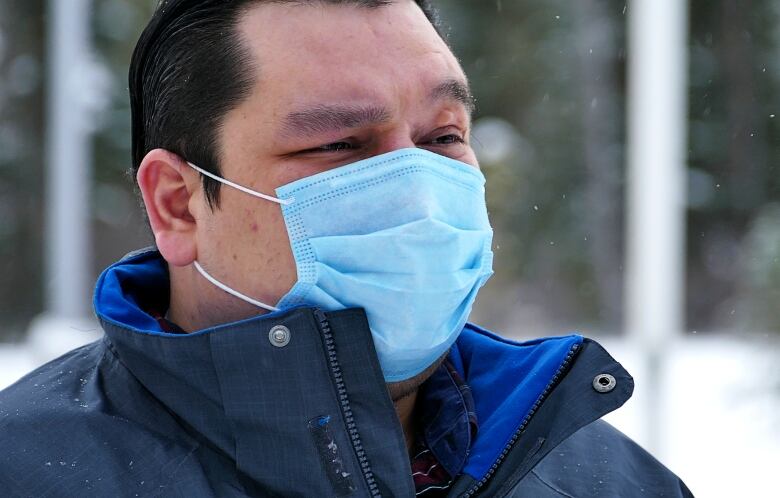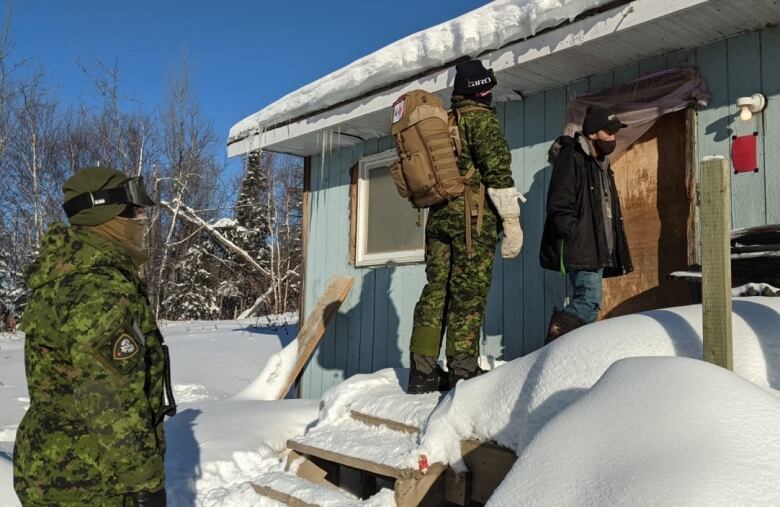Wood chopping and frozen trucks: Report shows successes, challenges in military's First Nations COVID response
Military response in northern Manitoba involved mundane tasks like cleaning, delivery as well as medical care

When aHercules aircraft broughtmilitary personnel toRed Sucker Lake First Nation in December, following a plea for help to contain aCOVID-19 outbreak, Chief Samuel Knottdidn't expectthe soldiers would betasked with chopping firewood.
Almost all of the 1,100 membersof the community, about 535 kilometres northeast of Winnipeg, had to isolate because of a COVID-19 outbreak, whichmade simple things challenging.
Many of the homes are heated with wood stovesand peoplecan't drink tap water, so tasks likehelping to cut and deliver wood in 40 C temperatures, anddelivering food and drinking water, werenearly as important as helping with medical care.
"They practically did everything, helping us out," Knott said.
Some of the worstCOVID-19 outbreaks in Manitoba have happened in the most remote parts of the province, which meant help was neededfrom the Canadian Armed Forces troops called on to respond to crises.
Internal documents obtained by CBC News throughaccess to informationrequests paint a picture of those public health crises, but also point to a number of other challengesthe military navigated as it attempted to support First Nations.
Between November and March, the Canadian Armed Forces responded to requests for assistance from seven remote communities in Manitobabattling outbreaks,all the while dealing with extreme cold and a lack of access to necessities,and learning on the fly.
In some areas, there was "complete community paralysis as a function of near total virus exposure," aninternal report on the Manitoba military operationssaid, referring to Shamattawa and Red Sucker Lake First Nations in the province's northeast.
"Communities were no longer capable of sustaining themselves."
First Nations leadershave said that's because of systemic problems like poverty, overcrowded housing, and lack of access to water and other resources, along with the challenges of the First Nations' geographic location.

Armed Forces personnel were in Shamattawa, about 745 kilometres northeast of Winnipeg, between Dec. 12 and 31. Chief Eric Redhead says the situationwas dire because most of the 1,300 people in the community were isolating.
"At the time we had no resources," Redhead said. "Our manpower was completely, completely down."
ThroughOperation Laser the official name for the Armed Forces' COVID-19 pandemic responsesoldiers with medical backgrounds were deployed to these communities and others to set up places for sick people to isolate, distribute food and firewood to households, share public health information, and support overwhelmed health-care workers in the community.
"They were able to communicate to us what they needed us to do, and we were able to go in there and just fill those blanks," said Cpl. Shauna Burton, who was part of a medical team.
'Required to rapidly self-educate'
In January and early February,military personnelin Garden Hill First Nation weretasked with setting up a space in the high schoolfor community memberswho couldn't self-isolate at home.
The problem was thatthere was no local expertise on how to set it up, nor were there any external experts who were able to go to the community about475 kilometres northeast of Winnipeg to advise, the internal reportsays.
The team "was required to rapidly self-educate, plan, liaise, establish the facility and develop an operating concept with very little relevant integral experience," it reads.
Later, key external resources both people and documents were discovered that could have been useful to the team, including the fact there is a provincial lead on isolation accommodations, the document says.
A spokesperson from Shared Health says the provincial health organization worked remotely with the military, sharing relevant documents and experience.
"I know there at the beginning they [the military] didn't really know what to do, like how to run the [alternate isolation accommodations]," said Oberon Munroe, Garden Hill's health director.

Munroe saysthe process became smoother once there was more communication between community members and the military.
That included tapping into the previous expertise of Garden Hill health-care workersinsetting up an isolation space in the elementary school for community membersrequired to quarantine after travelling off-reserve, or for those whobeing flown out to isolate in Winnipeg.
'Moving mountains'
In many of the communities, the military dealt with frigid winter temperatures, which affected the equipmentthey needed.
Armed Forces membersstationedin Pauingassi First Nationbetween Feb. 6 and 20faced wind chills of 35and below.
The mission to the fly-in community,about 280 kilometres northeastof Winnipeg,was requested afternearly 30 per cent of the population tested positive for COVID-19and many others were exposed.
"Vehicles could not be started some mornings. Vehicles loaned by the community and the RCMP also had difficulty," a military report said.

The same issue plagued the military operation in Shamattawa, Redhead says.
The military was stationed at the local school, which also served as a location for people to isolate but getting fuel to heat the buildingproved difficult because of the cold. The fuel truck was exposed to the elements a lot of the time and sometimes wouldn't start.
An added issue was scarcity of resources in the area.
Not only was it difficult to find enough vehicles for the troops to use, parts had to be ordered from urban centres and shipped up on planes, which took several days.
"Little things like that might not seem like a big deal to some, but for a community like mine that's moving mountains," Redhead said.
The military reports indicate these are lessons and roadblocks to be aware of that caninform future missions to remote communities, including Operation Vector, an ongoing mission to help remote communities administer vaccines.
Communities like Shamattawa First Nation are just glad to now have a handle on COVID-19.
Redhead says there were no active cases in the communityas of Wednesday.
"I don't know how we would have made outif we hadn't gotten the support of the Armed Forces. I don't even want to think about it. It would have been really, really bad."












_(720p).jpg)


 OFFICIAL HD MUSIC VIDEO.jpg)
.jpg)



























































































